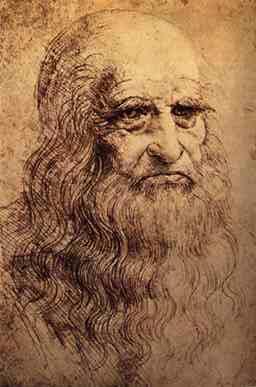

In 1472 Leonardo became a member of the painter's guild of Florence. In 1476 he was denounced by the Night Watch, but was acquited of the charge of immoral conduct.
One of his most popular early works, "The Adoration of the Magi," was painted
in 1481 for the Monastery of San Donato a Scopeto as an altar piece. It
was never finished due to his departure for Milan, where he offered his
services to Duke Ludovico il Moro. He worked on the Duomo in Milan and
the Duomo and Castle in Pavia; and painted the Madonna
of the Rocks
and the Last Supper at
this time. He also set up festivals for the Duke and claimed to be
an expert in military engineering and arms.
During the next few years, Leonardo wandered from
Mantua, in the court of Isabella d'Este, Venice, where
he was consultant for architectural matters from 1495
to 1499, to Florence; before becoming military
engineer for Cesare Borgia between 1502 and 1503.
The death of Pope Alexander VI changed the fortunes
of Duke Valentino, and Leonardo returned to Florence
in 1503, remaining there until 1506. The Florentine
Republic commissioned him to execute a large fresco
of the battle of Anghiari for one of the walls of the
Sala del Gran Consiglio in the Palazzo della Signoria
facing a fresco by Michelangelo, one of his rivals.
Leonardo experimented with a new technique of
fresco, which deteriorated quickly and eventually was
lost.
It was in Florence that Leonardo had his greatest
following, and it was during his years there that he
painted such classics as the Mona Lisa.
In 1506 Leonardo obtained temporary leave from the
Florentine Republic in order to return to Milan, where
he was to finish certain projects which he had left
incomplete due to his earlier hasty departure. In Milan
he once again came into contact with the French, who
repeatedly asked the Florentine Republic to extend
Leonardo's leave.
Between 1507 and 1508 Leonardo visited Florence to
settle his father's estate. He then spent many years in
Milan with the title of "peintre et ingenieur ordinaire".
He devoted much of his time to scientific studies and
to the engineering projects such as the channeling of
the course of the Adda river.
The return of the Sforza family in 1512 forced
Leonardo to leave Milan once again. From 1513 to
1516 he was in Rome at the Palazzo Belvedere under
the protection of Giuliano dei Medici, the brother of
Pope Leo X. Here Leonardo came into contact with
Michelangelo and Raphael; both younger, and both
rivals.
After the death of Giuliano dei Medici, Leonardo
accepted an invitation from his French friends and
moved to the castle of Cloux near Amboise, where he
stayed with his faithful pupil Melzi.
Leonardo died on May 2, 1519, and was buried in the
cloister of San Fiorentino in Amboise.